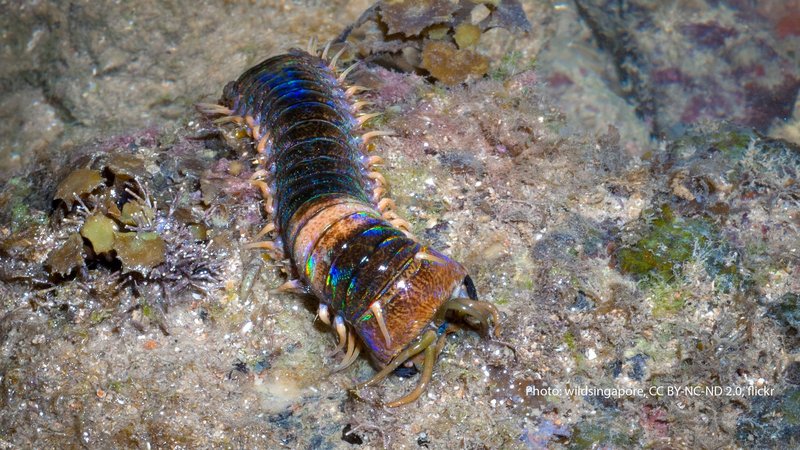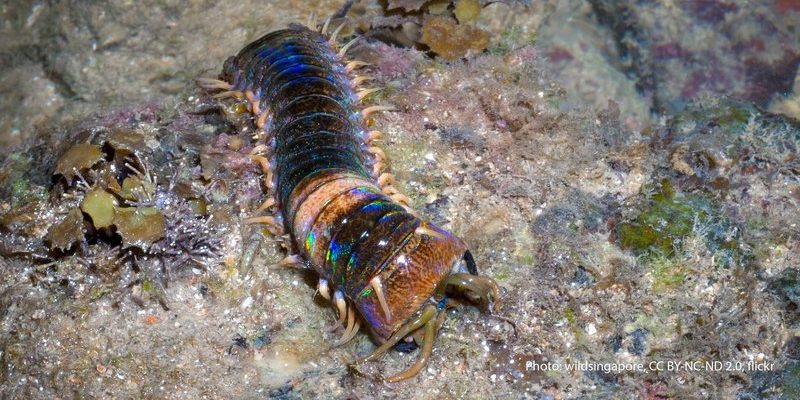
Bobbit worms, or *Eunice aphroditois*, are not your typical marine creatures. They can grow over three feet long and are equipped with a range of jaw-dropping adaptations. Just picture a worm that resembles a colorful, furry caterpillar. But instead of munching on leaves, it uses its impressive skills to snag fish and other small marine animals. These traits have been fine-tuned over generations, allowing them to thrive in diverse ocean ecosystems. Here’s a closer look at what makes the bobbit worm a top-tier hunter.
Camouflage: Blending with the Ocean Floor
One of the bobbit worm’s most effective evolutionary traits is its remarkable ability to **camouflage** itself. Picture a magician performing a trick—making something disappear from view. Bobbit worms do something similar in their underwater habitats. They often bury themselves deeply in the sand or mud, leaving only their colorful, feathery antennae exposed.
This clever tactic serves multiple purposes. First, it helps them blend into the intricate textures of the ocean floor, making it nearly impossible for prey to spot them. You might be wondering how this all works. Well, many fish and unsuspecting creatures swim close to the bottom, searching for food. If they can’t see the threat, they’re easy pickings!
Additionally, this camouflage protects the worm from predators. Larger fish and other marine animals that might want to snack on bobbit worms have a hard time spotting them. It’s like playing hide and seek, but the worm is really good at hiding!
Lightning-Fast Strike: A Predatory Advantage
If you thought the worm’s stealth was impressive, wait until you hear about its hunting technique. Bobbit worms have an astonishingly **fast strike** that often catches their prey off guard. When a fish or crustacean comes within reach, the worm can extend its powerful jaws in a fraction of a second.
Imagine a catapult launching a projectile at lightning speed; that’s how swiftly a bobbit worm can pounce on its prey. This rapid movement is thanks to its specialized muscles and a unique jaw structure. Once the jaws clamp down, it’s nearly impossible for the prey to escape. Honestly, it’s a bit like watching a horror movie in slow motion—exciting and a little nerve-wracking!
This ability not only increases hunting success rates but also allows the bobbit worm to take down prey much larger than itself. By overpowering its target with sheer speed and strength, the worm ensures it gets a satisfying meal every time.
Sharp, Retractable Jaws: Nature’s Scissors
Have you ever tried cutting something with dull scissors? Frustrating, right? Bobbit worms solve this problem with **sharp, retractable jaws** that resemble a pair of scissors or a set of pincers. These jaws are lined with tiny, serrated teeth that enhance their ability to grip and tear food.
When the worm strikes, its jaws extend from the mouth, snapping shut with incredible power. This design is similar to how a trapdoor works: once it’s shut, there’s no chance of escape for the prey. The serrated edges not only cut through flesh but also help the worm keep hold of slippery creatures that might try to wriggle away.
This unique jaw structure is a game-changer. It gives the bobbit worm an edge when competing with other marine predators. While some animals might struggle with tough shells or thick skin, the bobbit worm’s jaws are perfectly adapted for snatching a variety of prey.
Smart Hunting Strategies: Ambushing Like a Pro
Another fascinating aspect of bobbit worms is their **hunting strategy**. They are masters of ambush, waiting quietly for the right moment to strike. Think of them as highly trained soldiers, lying in wait until they get the green light to charge.
Bobbit worms typically choose locations near coral reefs or rocky substrates. These environments are bustling with smaller fish and invertebrates, making them prime hunting grounds. By combining their stealthy camouflage and quick strikes, they can effectively ambush a range of prey, from small fish to crustaceans.
What’s impressive is that these worms can also sense vibrations in the water, which helps them detect nearby movement. When they feel a potential meal approaching, they’ll be ready to unleash their swift attack. This blend of patience and precision highlights their evolutionary success as hunters in an ocean teeming with life.
Adaptability: Thriving in Diverse Environments
Bobbit worms are not picky eaters. Their **adaptability** allows them to thrive in various marine environments, from shallow coastal waters to deeper oceanic regions. This versatility is a significant factor in their hunting success.
For example, some bobbit worms prefer sandy or muddy substrates, while others might choose rocky crevices. This ability to live in different environments means they have access to a more extensive range of prey. Whether it’s a tasty fish or a succulent shrimp, a bobbit worm will find a way to survive and thrive.
Moreover, they can adjust their hunting strategies based on what’s available in their habitat. If fish are scarce, they might focus on smaller invertebrates or even detritus. This flexibility shows just how well adapted bobbit worms are to changing conditions, making them formidable predators.
Bobbit worms are fascinating creatures that showcase the incredible power of evolution. Their ability to blend into their surroundings, lightning-fast strikes, sharp jaws, effective ambush tactics, and impressive adaptability all contribute to their status as elite hunters. Just picture them, patiently waiting beneath the ocean floor, like a skilled archer ready to release an arrow.
By understanding these traits, we can appreciate the complex ecosystems in which they reside. These worms remind us that even the most seemingly simple creatures have remarkable adaptations that allow them to thrive. So, the next time you marvel at the ocean’s wonders, don’t forget about the bobbit worm, the ninja of the sea!

